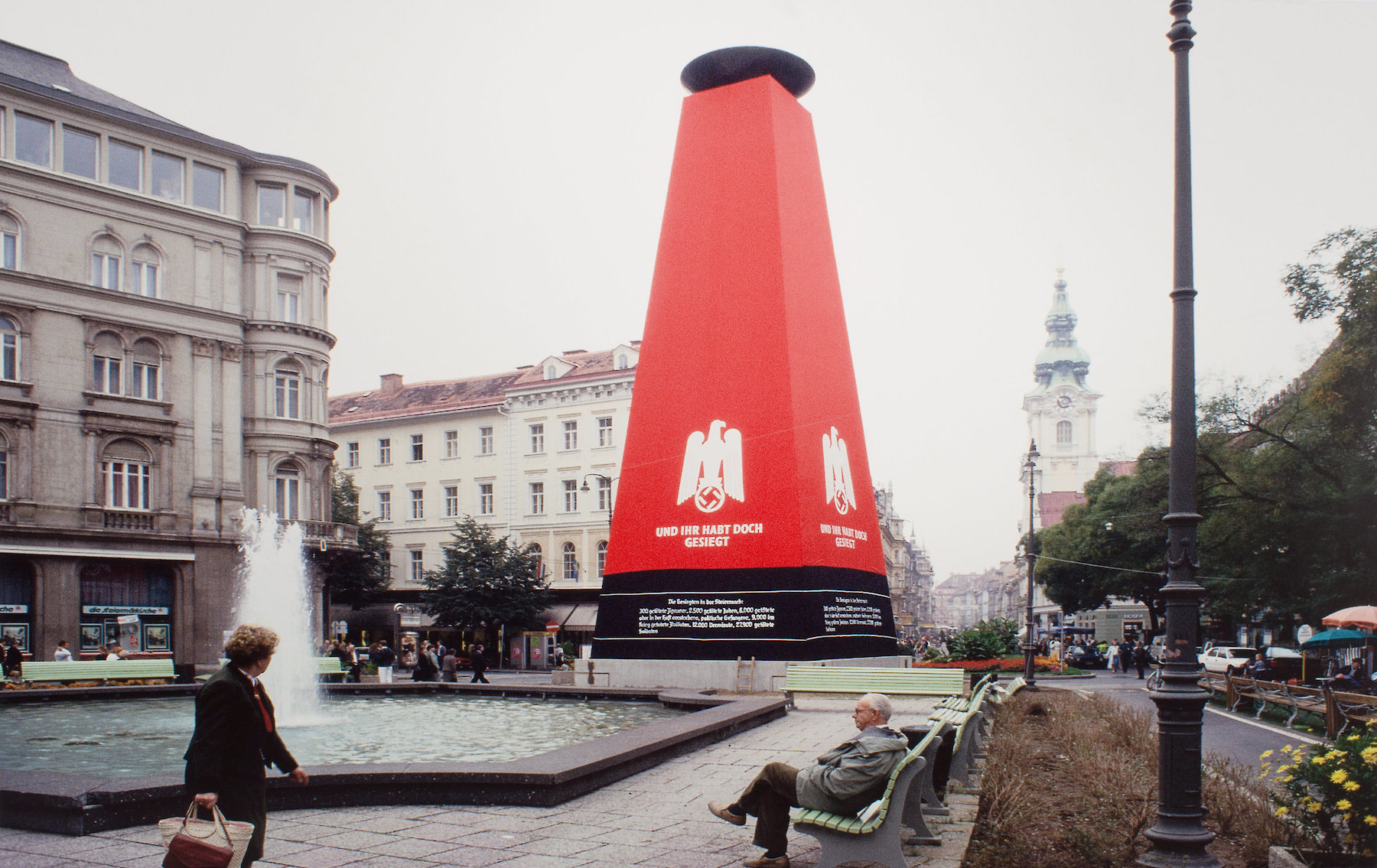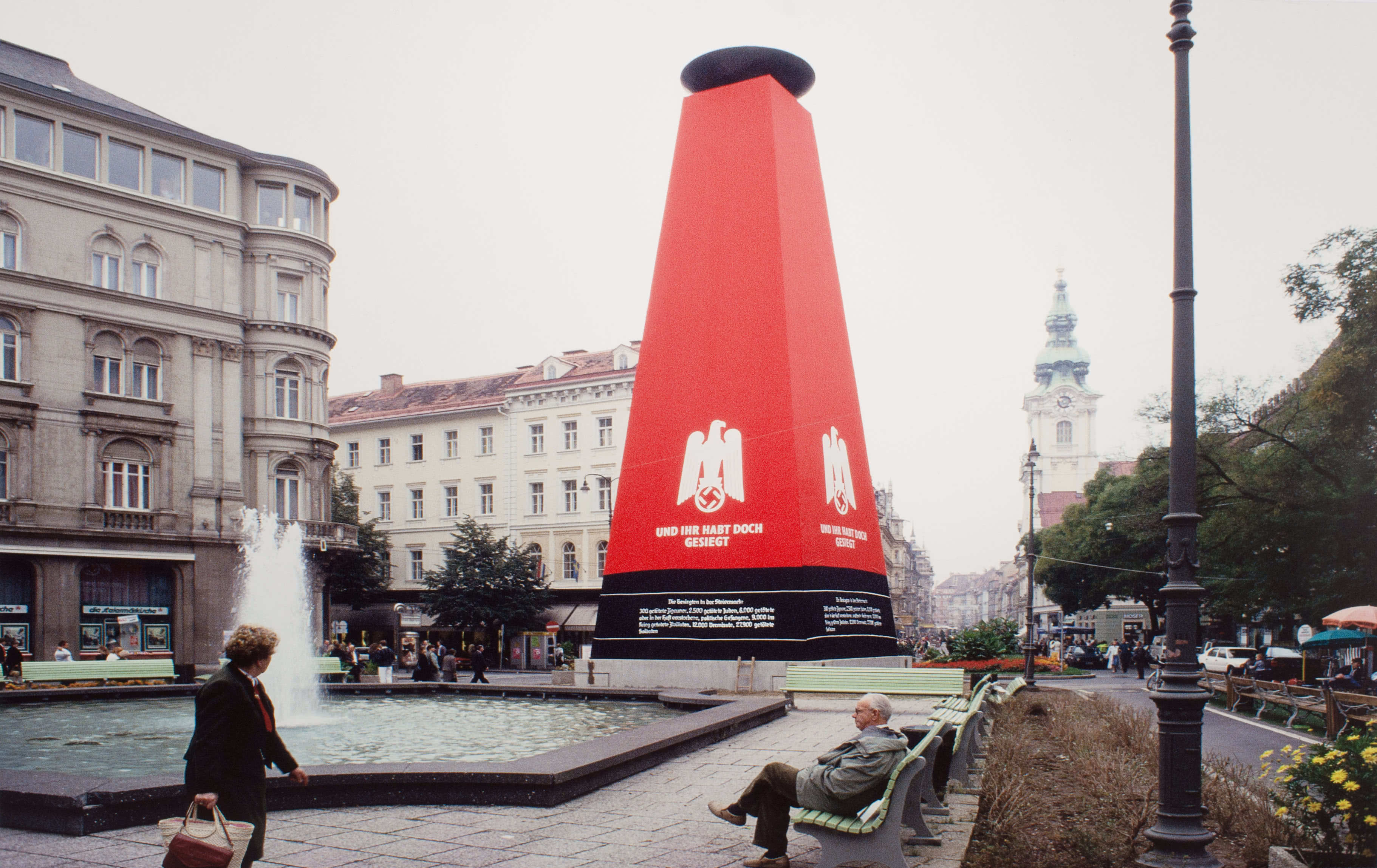
After Hans Haacke veiled the Marian Column at the Eisernes Tor (Iron Gate) with a sheathing reminding of the National Socialist demonstration in 1938, it was set on fire by right-wing extremists.

Und ihr habt doch gesiegt (And You have Won After All) Hans Haacke, 1988
“Guilt and Innocence”
The (missing) reappraisal of the National Socialist past in Austria was also criticized by artists from the 1980s at the latest. As part of the steirischer herbst festival 1988, initialized by the art historian Werner Fenz, the artist Hans Haacke created a reconstruction of the obelisk with which the National Socialists had encased the Marian column at Eisernes Tor in 1938. At that time, the victory symbol was intended as an acknowledgement for the “City of the Popular Uprising”. With his memorial, Haacke drew attention to the crimes of the Nazi era. Right-wing extremists set it on fire. The general public responded immediately with protests in front of the burnt down obelisk.
Laminated photograph on aluminium
67 × 100 cm
Lender: Hans Haacke
Hans Haacke
Points of Reference between 1938 and 1988
On the occasion of the commemoration of the “Anschluss” in 1938, the steirischer herbst festival 1988 was dedicated entirely to the subject of the National Socialist past: artistic projects were intended to raise public awareness. 16 international artists were invited to work on this subject. One of the most eye-catching works in public space was “Und ihr habt doch gesiegt“ (And You Have Won After All) by the German-American artist Hans Haacke, who works in a strongly political, socio-critical and deliberately provocative manner.
“And You Have Won after All“
On 25 July 1938, a pompously staged propaganda show took place in Graz as in many Austrian cities—a “commemoration of the dead” for the “killed blood witnesses of the movement”. From Main Square, then “Adolf Hitler Square”, via the Herrengasse to the square at Eisernes Tor, then “Bismarck Square”, the city centre of Graz was covered with swastikas. At today’s Eisernes Tor, the “monument of victory” marked the climax of the show: a 20-metre-high wooden obelisk, decorated with red flag fabric and National Socialist symbols, bearing a fire bowl. The column with the inscription “Und ihr doch gesiegt” (And you have won after all) was dedicated to the Nazi perpetrators of the attack against the “Corporative State” dictatorship under Dollfuß in July 1934.
Provocation of Memory
The public reappraisal of the Nazi past in the Second Republic was progressing only hesitantly, and radical right-wing groups were booming. Hans Haacke opposes this with a symbol nobody would fail to notice: Fifty years after the National Socialist “commemorationl to the dead”, Hans Haacke had this “monument of victory” reconstructed again at the same place in order to reinterpret it as a memorial for the victims of the Nazi terror regime. The number of victims formed a textual add-on to the obelisk. In addition, text panels with information on National Socialist ideology and inhuman acts were set up.
Public Reactions
Hans Haacke’s memorial attracted public attention. The monumentality of the work, erected in its original colouring, urged controversy. This was reinforced by the fact that its significance only became apparent at second glance, through a deeper understanding of the subject matter. Attacks on the artwork carried out by radical right-wing circles were feared. Despite special security measures, an arson attack from the neo-Nazi scene led to its destruction and severe damage to the Marian Column below. The perpetrators of the attack were convicted of re-engagement in National Socialist activities.